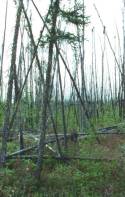    



|
|
Changing Ecosystems
Ecosystems are not unchanging. Natural changes in climate will result in a change in environmental conditions, which results in a change in ecosystems. The influence of mankind can change the ecosystem. These influences may be direct or indirect. Examples of direct influences are logging and agriculture where the original vegetation is removed. Indirect influences result from global changes in the environment caused by civilization, like
global warming due to the release of greenhouse gases. In many cases,
an ecosystem changes and may appear different. For example, after the
glaciers retreated from Alberta there was
very little fertile soil. The first plants to grow were very hardy ones
called pioneer species, such as lichens and grasses. These plants became established in the sand, silt and clay that covered the landscape. Their roots grew into cracks and helped to
break down these mostly unfertile materials. When these plants died, the organic material in them combined with the sand and clay to form a simple soil.
 This soil allowed other types of plants to become established. As the soil layer grew deeper, larger and stronger plants became established, and some of the original plants were replaced. This replacement of some plant species with others, and the associated change in animal species, is called
succession. An ecosystem that is in a stable state, or is not in the process of being succeeded by another, is known as a climax community.
Natural processes such as fire, flooding, and insect invasion can
disturb whatever plant and animal species are present, and radically change the local environment. The area then starts the successional sequence again, beginning with the pioneer species and building towards the climax community. In this way, the ecosystems are constantly being rejuvenated by the
environment It is important to note, however, that just because an
ecosystem has reached a "climax" does not mean it stops
changing. Like all ecosystems, a climax community is in constant
flux. This soil allowed other types of plants to become established. As the soil layer grew deeper, larger and stronger plants became established, and some of the original plants were replaced. This replacement of some plant species with others, and the associated change in animal species, is called
succession. An ecosystem that is in a stable state, or is not in the process of being succeeded by another, is known as a climax community.
Natural processes such as fire, flooding, and insect invasion can
disturb whatever plant and animal species are present, and radically change the local environment. The area then starts the successional sequence again, beginning with the pioneer species and building towards the climax community. In this way, the ecosystems are constantly being rejuvenated by the
environment It is important to note, however, that just because an
ecosystem has reached a "climax" does not mean it stops
changing. Like all ecosystems, a climax community is in constant
flux.
[What is
an Ecosystem?][How Ecosystems
Develop]
[Changing Ecosystems][Population
Controls]
[Food Webs][Plant
Life]
|
 Heritage Community Foundation Presents
Heritage Community Foundation Presents









